With the diverse ecosystems in Florida, you can expect a wide variety of snake species. There are around 55 different species of snakes in the state, with six of those being venomous. But if you saw a black snake in Florida, how would you know what kind it was? You would be wrong if you immediately assume it is a black mamba.
First off, black mambas are not black. They are more gray or dark brown, and secondly, black mambas do not live in Florida. Black mambas get their name from the black inside of their mouths, and they live in sub-Saharan Africa. So, if it is not a black mamba, what are some of the black snakes in Florida?

©
How many species of black snakes are in Florida?

There are eight different species of snakes in Florida that are black.
©Breck P. Kent/Shutterstock.com
There are eight different black snake species in Florida. There’s also one honorable mention (you will see why!).
Are any of the black snakes in Florida poisonous?
The only black snake that is poisonous in Florida is the cottonmouth (also called the water moccasin). The other poisonous (or venomous) snakes in Florida are the eastern copperhead, eastern diamondback rattlesnake, timber rattlesnake, dusky pygmy rattlesnake, and the harlequin coral snake.
List of black snakes in Florida
Black swamp snake

Black swamp snakes can be easily identified by their red or orange belly.
©iStock.com/passion4nature
- Size: 10-15 inches (25-38cm) long, small skinny snake
- Coloration: shiny black with a bright red or orange belly
- Similarity to others: there are no other Florida snakes with the same coloration
- Venomous or non-venomous: non-venomous
- Habitat: aquatic, lives in marshes, swamps, lakes, ponds, and slow-moving streams
- Location in Florida: throughout most of Florida and into the panhandle, not found in the Keys
Brahminy blind snake

The
brahminy blind snake
is one of the smallest snake species and looks like an earthworm.
©Patrick K. Campbell/Shutterstock.com
- Size: tiny snakes, only 4.5-6.5 inches (11-16cm), look the same at both ends, hard to tell heads from the back end, and have tiny, imperceptible eyes which give them their nickname “blindsnake.”
- Coloration: their whole body is the same color, black, dark gray, or even purplish
- Similarity to others: they look like a thicker earthworm!
- Venomous or non-venomous: non-venomous
- Habitat: similar to earthworms, they prefer to burrow in loose soil and leaf piles
- Location in Florida: found from Key West up the coast and throughout most of the state, rarely in the panhandle
Eastern indigo
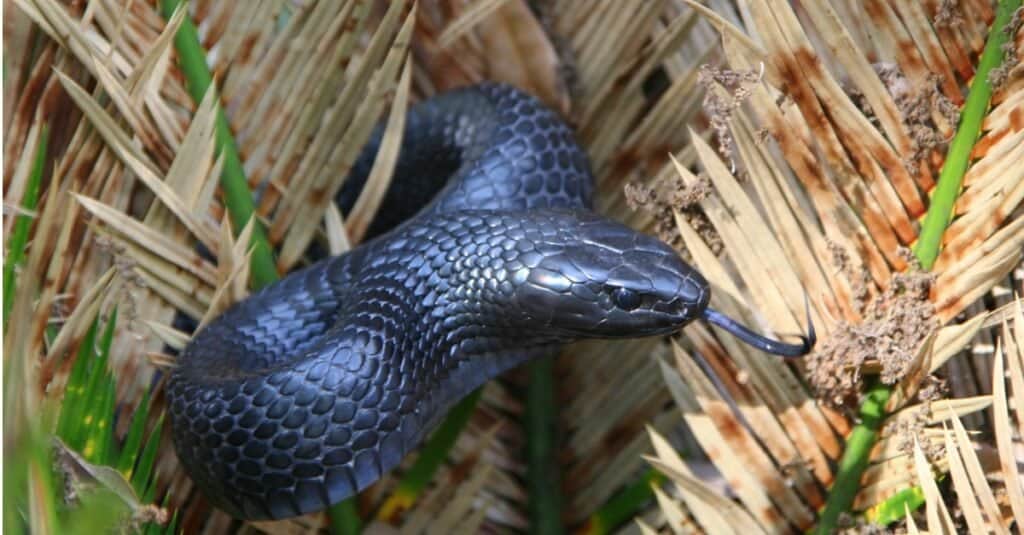
The eastern indigo is one of the largest black snakes in Florida.
©iStock.com/sstaton
- Size: 60-82 inches (that is 5-6 ½ feet!), thick-bodied snake
- Coloration: black with iridescent purple and blue hue with the sunlight, reddish-orange markings under the chin
- Similarity to others: North American racers and eastern coachwhip
- Venomous or non-venomous: non-venomous
- Habitat: a variety of environments, including scrub, prairies, coastal dunes, edge of freshwater marshes, like to live in the burrows of gopher tortoise
- Location in Florida: found throughout the state, although very rarely seen in the Keys
Florida cottonmouth
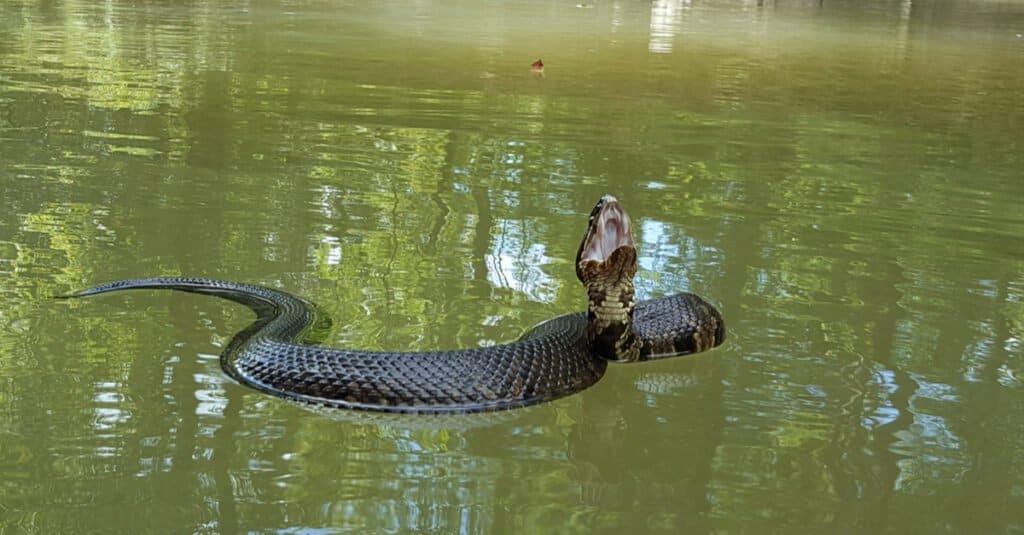
The Florida cottonmouth is huge and venomous.
©Seth LaGrange/Shutterstock.com
- Size: 30-48 inches (2.5-4 feet) long, thick-bodied
- Coloration: start tan with dark-brown markings, but as they get older, they get darker, and some senior snakes eventually become completely black with faint dark markings
- Similarity to others: they look a lot like other non-venomous water snakes like the saltmarsh snake and the Florida green watersnake
- Venomous or non-venomous: venomous
- Habitat: swamps, rivers, lakes, ponds, ditches, retention pools
- Location in Florida: they are found in all of Florida’s counties, including the Keys and a few offshore islands.
Glossy swamp snake

The glossy swamp snake lives in swamps, marshes, lakes, and ponds.
©Rusty Dodson/Shutterstock.com
- Size: 14-24 inches (36-60cm), small snake
- Coloration: looks black but may be more of dark olive, have a faint stripe down their back and on either side, yellowish lips
- Similarity to others: the striped swamp snake
- Venomous or non-venomous: non-venomous
- Habitat: aquatic, swamps, marshes, slow-moving waterways, lakes, ponds, ditches
- Location in Florida: from central Florida NW to the panhandle
North American racer
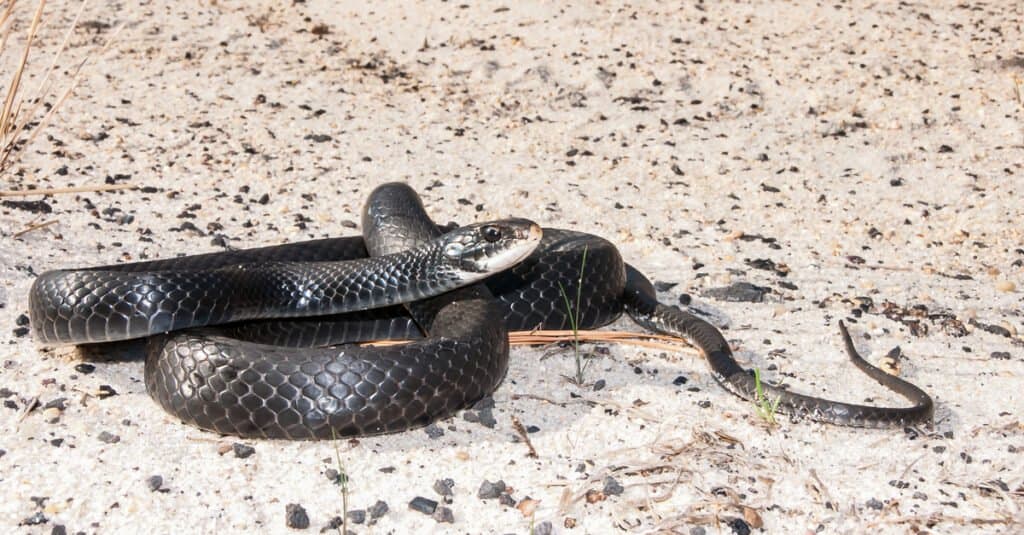
The North American racer is a fast snake that lives throughout Florida, including the Keys.
©Jay Ondreicka/Shutterstock.com
- Size: 20-55 inches (50-142cm), long skinny snake
- Coloration: all black with a white chin, large eyes
- Similarity to others: eastern indigo and eastern coachwhip
- Venomous or non-venomous: non-venomous
- Habitat: prairies, scrubs, forests, and suburban backyards
- Location in Florida: throughout Florida, including the Keys
Ring-necked snake
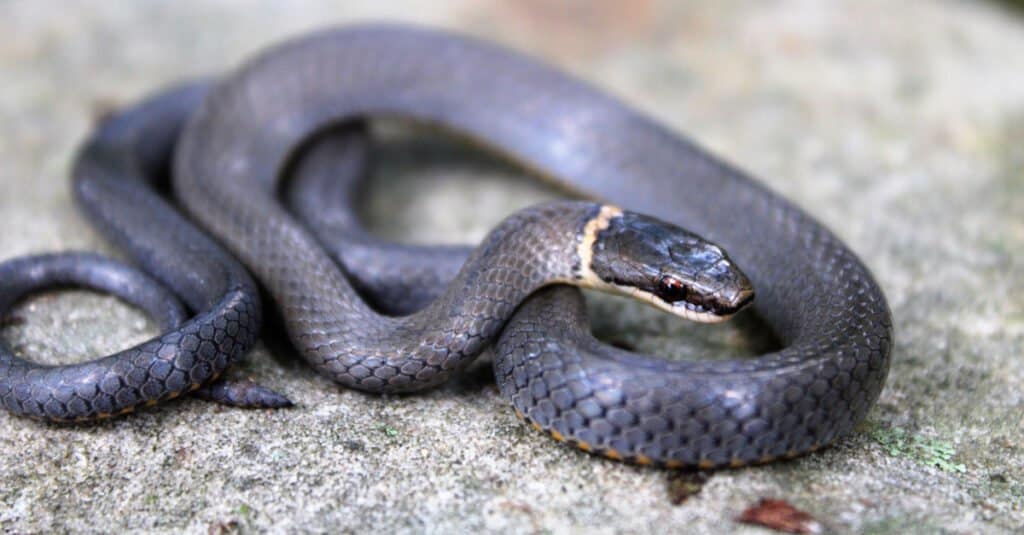
Ring-necked snakes get their name from the dog collar-like ring around their neck.
©Tucker Heptinstall/Shutterstock.com
- Size: 8-14 inches (21-36cm), tiny snake
- Coloration: all black with a bright red, orange, or yellow belly, also has a colored ring around its neck like a dog collar
- Similarity to others: the black swamp snake, look for the collar to tell them apart
- Venomous or non-venomous: non-venomous
- Habitat: prairies, meadows, and suburban backyards
- Location in Florida: throughout Florida, including the Keys
Saltmarsh snake
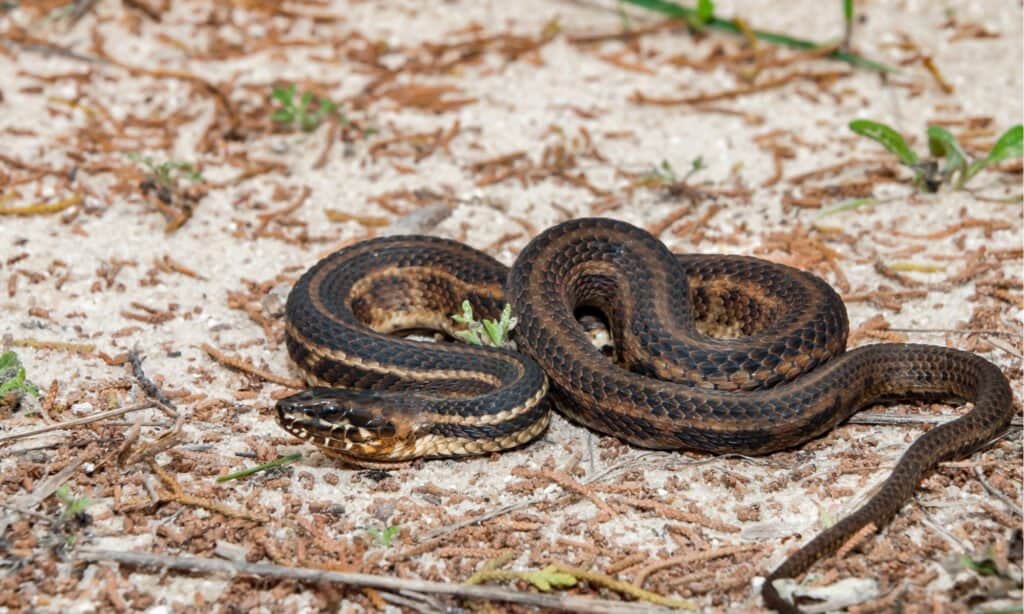
The saltmarsh snake can be found all along the coast of Florida.
©Jay Ondreicka/Shutterstock.com
- Size: 15-30 inches (38-76cm), medium-bodied
- Coloration: wide variation in color, but are sometimes all black with faint dark stripes down the side
- Similarity to others: Florida cottonmouth, which can be a problem since the cottonmouth is venomous; better to stay away from all black watersnakes
- Venomous or non-venomous: non-venomous
- Habitat: aquatic, prefers coastal areas, marshes, mangroves in both fresh and saltwater estuaries, like to live in crab burrows
- Location in Florida: found along the perimeter of Florida along the coasts, including the Keys
Honorable Mention: Eastern Coachwhip
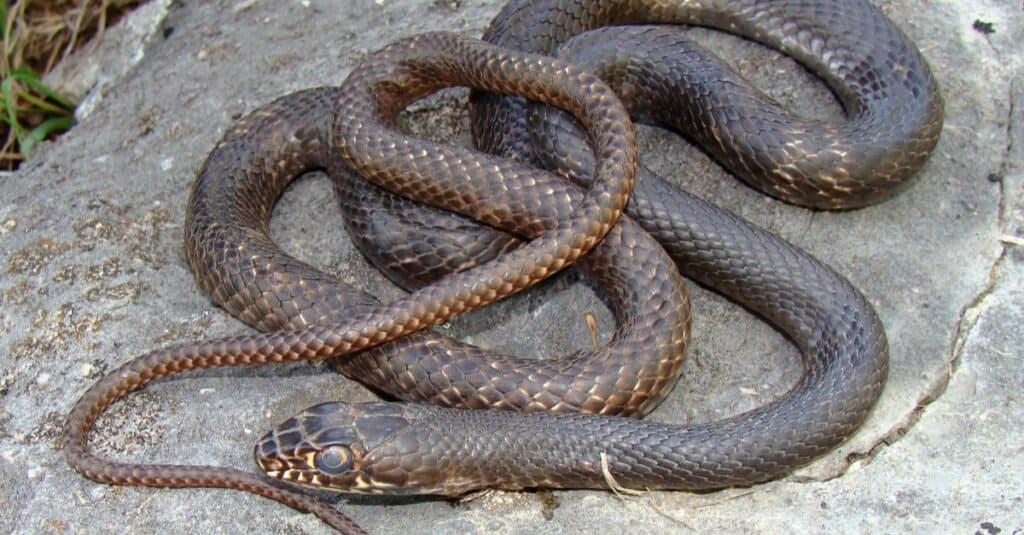
Coachwhip snakes are non-aggressive snakes found in South America.
©Matt Jeppson/Shutterstock.com
If you see a black snake in Florida, now you will have a better idea of how to identify it. There is one more notable black snake in Florida that deserves mentioning. The eastern coachwhip is not all black like the snakes on our list, but if you only saw a glimpse of the first foot of the head and body, it would appear to be all black. Their body then fades into a light tan. Because of this dark gradient, they made our list as an honorable mention.
- Size: 42-60 inches (107-152cm), heavy-bodied
- Coloration: heads are all black, and then after about a foot, it gradually fades to a light tan
- Similarity to others: Eastern Indigo and North American Racer
- Venomous or non-venomous: non-venomous
- Habitat: sandhills, scrubs, along beaches, prefer hot, dry habitats
- Location in Florida: throughout Florida except in the Keys or some of the southern wetlands
Is It Normal to be Bitten by a Snake in Florida?
While snakes are abundant in Florida, most of them are non-venomous and will not cause serious harm if they bite. However, studies estimate about 300 venomous snake bites occur each year in Florida. Fatalities are much rarer, as most can be avoided if antivenin is administered in time, this is a medicine that counteracts the effects of snake bites and is made out of antibodies derived from the snake’s venom. If you are bitten by a snake call 911 immediately, even if you expect it to be non-venomous, as many species can be hard to distinguish to an untrained eye.
How Long Do Snakes Live?
Due to natural predators and the destruction of their natural habitats by humans, many snakes do not make it to adulthood in the wild. Under optimal conditions with no threat of predation, most species of snake can live 20-30 years. If a snake is kept by an experienced and caring owner, its chances of living a long and healthy life increase dramatically. The oldest known snake to ever live was a Colombian rainbow boa by the name of Ben. He lived to be 42 years old, and his owners received a Guinness World Record for raising the oldest snake ever.
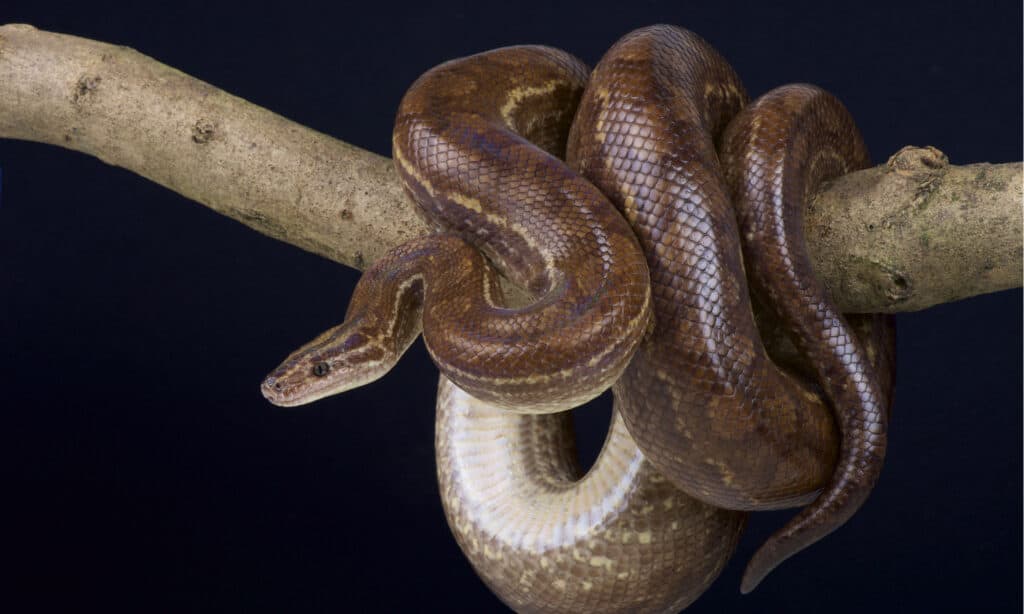
The oldest known snake, Ben, was a Colombian Rainbow Boa.
©reptiles4all/Shutterstock.com
The photo featured at the top of this post is © Jay Ondreicka/Shutterstock.com
Discover the "Monster" Snake 5X Bigger than an Anaconda
Every day A-Z Animals sends out some of the most incredible facts in the world from our free newsletter. Want to discover the 10 most beautiful snakes in the world, a "snake island" where you're never more than 3 feet from danger, or a "monster" snake 5X larger than an anaconda? Then sign up right now and you'll start receiving our daily newsletter absolutely free.
Thank you for reading! Have some feedback for us? Contact the AZ Animals editorial team.






